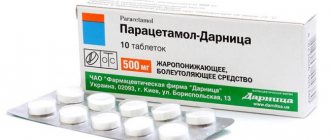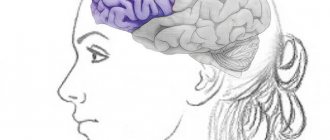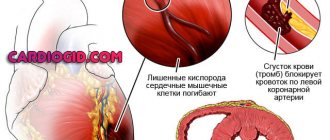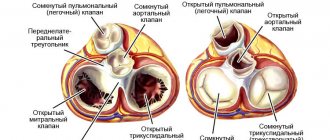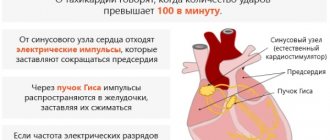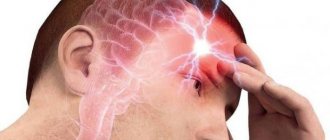What is a vegetative crisis, how is it classified?
A vegetative crisis is an extreme form of expression of VSD (vegetative-vascular dystonia), which is characterized by a disorder of the nervous system. In the International System of Classification of Diseases (ICD), this pathology is coded F 41.0.
The classification of vegetative crises is carried out according to several types, which is determined by the severity of the disease and the totality of the existing symptoms.
Depending on the severity of the course, a vegetative crisis can be:
- light – lasts a maximum of half an hour. Accompanied by minor but characteristic violations;
- medium – lasts about an hour. This form is characterized by multiple somatic disorders with the further formation of asthenia (neuropsychic weakness), which persists throughout the day;
- severe – lasting more than an hour. The appearance of various disorders is noted, accompanied by various paroxysms and the subsequent development of asthenia, which persists for several days.
In modern medicine, vegetative crises are also divided into 4 types in accordance with the symptoms that appear. According to this classification they are:
- sympathetic-adrenaline. Manifested by severe anxiety, discomfort in the heart, rapid pulse and high blood pressure;
- vagoinsular. The patient feels his heart sink, then notes the onset of weakness, lack of air, and a decrease in blood pressure;
- vegetative-vestibular. In this case, the person complains of dizziness, vomiting, which appears with a sudden change in posture: turning the head, bending over and other movements;
- hyperventilating. Manifests itself in the form of rapid breathing, increased blood pressure, dizziness, and muscle tone.
The occurrence of any vegetative crisis is acute and unexpected for a person. Sometimes it can appear at night. But such a phenomenon is not dangerous and does not threaten the patient’s life. Although at first glance the clinical picture is quite scary, the attacks always stop, so you should not be afraid of them.
Autonomic failure
Autonomic failure is a syndrome associated with impaired innervation of internal organs, blood vessels and endo- and exocrine glands.
In most cases, it is a progressive autonomic failure. In turn, MNV includes primary violations:
- idiopathic orthostatic hypotension;
- some hereditary and acquired diseases of the nervous system (multiple system atrophy, hereditary sensory-vegetative polyneuropathy)
Secondary violations include:
- for endocrine system disorders (diabetes mellitus, thyroid disease);
- for systemic and autoimmune diseases;
- for metabolic disorders;
- with paraneoplastic syndrome;
- for infectious diseases (HIV, leprosy, herpetic infections, etc.).
Various symptoms may occur:
- from the cardiovascular system: tachycardia at rest, orthostatic fainting, arterial hypertension in the supine position;
- from the respiratory system: sleep apnea, involuntary attacks of suffocation;
- from sweating: hypo- and anhidrosis, increased sweating;
- from the gastrointestinal tract: constipation, diarrhea, nausea, vomiting, anorexia;
- from the urinary system: urinary disorders, erectile dysfunction.
Diagnosis of this disease is carried out by physical examination, checking neurological status and drug tests.
Why does a vegetative crisis develop?
At present, the sources of this problem have not been fully investigated. Although some factors have been identified that can provoke the onset of a vegetative crisis. These include:
- tendency at the genetic level;
- hormonal imbalances (menopause, pregnancy, abortion);
- frequent stress, mental disorders (death of a loved one, difficulties with work or personal life);
- endocrinological pathologies;
- disturbances in the functions of the central nervous system;
- heavy physical activity;
- alcohol addiction;
- long-term treatment with potent drugs.
Scientists and psychotherapists have created a general description of subjects predisposed to this disease. Representatives of the weaker sex are more susceptible to vegetative crisis, who are characterized by the presence of:
- artistry;
- instability of thoughts;
- inclinations to dramatize any situation;
- constant expectation of troubles, fear of them;
- inadequate response to criticism;
- constant desire to improve your own figure.
It is precisely such people who are prone to developing unreasonable panic attacks, in which there is a feeling of anxiety and fear. Moreover, somatic symptoms are pronounced.
What causes severe crises
The root causes of such exacerbations are not yet fully understood. However, numerous studies and diagnostic results have made it possible to establish what may be the cause of the vegetative crisis:
- Hormonal imbalance and genetic predisposition;
- Long-term use of potent medications, stress, psycho-emotional imbalance;
- Endocrine disorders;
- Central nervous system disorders.
Often domestic violence and other social causes lead to an aggravation of a person’s condition, the first symptoms of a vegetative crisis.
Signs
The first symptom of the onset of a vegetative crisis is a strong feeling of anxiety that appears unexpectedly and without cause. It is impossible to predict what will trigger the next attack, which is why the patient is constantly in a feeling of fear.
During the development of an attack of vegetative crisis, adrenaline is sharply released into the bloodstream. As a result, a person feels the appearance of:
- rapid pulsation;
- lack of air;
- acute headache;
- tremors in the limbs;
- chills, increased sweating;
- discomfort in the heart area;
- severe weakness;
- dizziness;
- presyncope;
- fear of dying.
During an unexpected attack, a person may experience the development of several of the above symptoms, or all of them at the same time. The peak of the attack occurs after 10 minutes; when it ends, the patient begins to feel lethargic and drowsy; over time, the condition returns to normal without any complications.
During a vegetative crisis, the patient experiences severe stress. He develops a fear of a relapse, which contributes to the development of a second attack even under minor negative conditions. Another attack can be triggered by an unfamiliar environment, being in a confined space, or the threat of some kind of penalty.
Symptoms of the disease
Often, a vegetative crisis manifests its symptoms at 20–30 years of age; cases before 15 years and after 60 years are extremely rare. In women, the disease is detected 3 times more often than in the stronger sex.
The clinical picture of an attack consists of 70% vegetative signs that affect various body systems, the rest is emotional disorders. With the sympathoadrenal form, the following manifestations are observed:
- severe headaches;
- feeling of pulse in head;
- sensations of heartbeat failure;
- pale and dry skin;
- jumps in body temperature;
- numbness and trembling in the arms and legs;
- chill-like tremor;
- feelings of anxiety and fear;
- rise in blood glucose levels;
- the end of the attack is abrupt, with the release of a large amount of urine with a low specific gravity. A state of asthenia occurs.
- vagoinsular conditions are characterized by:
- a feeling of fading and disruption of the heart;
- feeling of suffocation;
- difficulty breathing;
- dizziness;
- rare pulse;
- wet, red skin;
- stomach pain, bloating, increased intestinal motility;
- The combination type is characterized by a combination of manifestations of the vagoinsular and sympathoadrenal types.
In general, an attack of fear or anxiety is characteristic, combined with 4 or more items from the list.
At the mental level, a feeling of derealization, depersonalization, fear of committing an unrestrained act, losing one’s mind, and fear of death may appear.
An atypical attack may manifest itself with the following symptoms:
- feeling of “lump in the throat”;
- feeling of weakness in the limbs;
- visual or hearing impairment;
- gait imbalance;
- speech impairment;
- loss of consciousness;
- convulsions;
- a feeling of arching of the body;
- nausea or vomiting.
If the first signs of rabies appear in a person, then treatment will no longer help and the only chance is to alleviate the suffering of the doomed person.
What are the consequences of a fracture of the vault and base of the skull? What consequences of this severe injury may appear in the near and distant future.
Diagnostic methods
Determining the presence of a vegetative crisis is quite difficult even for an experienced specialist. To confirm the diagnosis, a comprehensive diagnosis is necessary, which includes a medical examination, assessment of reflex functions, ECG, pulse check, blood pressure, etc. Only after receiving the results can we make assumptions about the presence of a vegetative crisis in the patient. The disease can be accurately diagnosed only when the attack is over by excluding the following ailments and conditions:
- cardiac dysfunction - requires 24-hour cardiac monitoring, stress ECG, and cardiac ultrasound;
- stroke, brain tumors - CT and MRI are required;
- vascular crisis - encephalography and CT are performed;
- bronchial asthma – it is necessary to carry out breathing tests and skin tests to determine allergies;
- internal blood loss - you need an ultrasound of the peritoneal and pelvic organs;
- hypertensive vegetative crisis - CT or MRI is performed;
- mental disorders - examined by a psychiatrist.
When all of the listed pathologies are excluded and it is determined that the peak of the crisis occurs 10 minutes after the onset, and in addition an anxious feeling or deep-seated fear appears, the patient is diagnosed with a vegetative-vascular crisis.
In some cases, a similar diagnosis is given to children. The cause of this phenomenon may be psychological trauma or stress. As a rule, the development of a vegetative crisis in childhood is caused by quarrels in the family.
Classification
The development of a tendency to vegetative crises can be called cardiac neurosis, based on this, three types of neurocirculation disorders are distinguished:
- A high level of pressure and cerebral vascular tone above normal is the sympathoadrenal type.
- Dilated vessels, increased blood volume, high myocardial load, reduced resistance of the vascular system - vagoinsular type.
- The intersection of symptoms of the first type with the second is called a mixed crisis.
There is a division of vegetative-vascular crisis according to the manifestation of symptoms, the complexity of the disease and the duration of the disease:
- The attack is short-lived, almost asymptomatic, after it there are no complications or weakness - a mild attack.
- The attack can last from 15 minutes to an hour, the symptoms are more pronounced, chronic fatigue and weakness can continue for several more days - average degree.
- Spontaneous motor activity, paralysis of the limbs, asthenia can last for several days - severe.
Possible consequences
The vegetative crisis itself does not cause harm to health, but if attacks occur frequently, this is fraught with serious consequences. The patient begins to suffer from numerous phobias: fear of dying, being in a confined space, etc. Due to frequent attacks, heart function may be impaired, and sudden changes in blood pressure may develop. In addition, problems with the digestive organs and nerves may appear.
Fear of developing another attack can affect personal characteristics. Often such people try to communicate less with others, which is why they become withdrawn, and sometimes they may develop inappropriate behavior.
Complications and prognosis
Constant anxiety is caused by the fact that the crisis is usually not limited to one panic attack and attack, they are repeated at different intervals, the person knows about this and fearfully awaits the next episode of exacerbation. The following complications may occur in such people:
- depressive problems. Due to the fact that a person is always in tension from waiting for a new attack, the nervous system suffers and the general psycho-emotional background drops;
- phobias. In order not to provoke a crisis, the patient avoids certain places, people, situations that could cause it;
- decreased social adaptation and resulting fatigue.
The prognosis will be encouraging if the patient seeks help in a timely manner and follows all the instructions of the psychotherapist.
How to treat manifestations of a vegetative crisis
To treat a vegetative crisis, an integrated approach is used, which includes not only medications. In accordance with the patient’s complaints, the doctor determines the duration of the attacks, the severity of the symptoms, and only then prescribes medications. In addition, the patient must learn to overcome attacks independently.
Drug treatment
For this disease, symptomatic therapy is prescribed. To stop an attack, the following may be prescribed:
- for cardiac dysfunction - Valocordin, Corvalol or Anaprilina;
- to eliminate anxiety - Relanium or Clonozepam;
- A course of treatment with antidepressants under medical supervision is also prescribed.
In addition, it will be necessary to treat somatic pathologies and abnormalities in the functions of the central nervous system identified during the diagnosis. The same actions can be used to stop an attack of vegetative crisis.
Non-drug treatment
A person diagnosed with a vegetative crisis must learn to identify the symptoms of an approaching attack and overcome it on his own. Breathing exercises are suitable to eliminate the problem. With proper and slow breathing, a large amount of oxygen enters the body, which helps reduce the severity of symptoms that appear during an attack. The supply of carbon dioxide to the body is also effective. For this purpose, you can use a paper bag to exhale and inhale into it.
If there is a suspicion that an attack has begun, the patient is advised to change the environment. To do this, you need to leave the room or transport, try to pay attention to the surrounding nature to distract your thoughts.
Treatment
To neutralize the vegetative crisis, complex treatment is selected. A set of measures can achieve the desired result. Vegetovascular disorder in the body is normalized with the help of anti-anxiety antidepressants and tranquilizers. I use the first ones on the list for six months, and the second ones for at least 2 weeks. Antidepressants are selected taking into account the individual characteristics of the body; they do not cause addiction or dependence. There are two approaches to treatment; the doctor and the patient decide which one to choose. If you choose a psychotherapeutic approach, then the treatment will be long with an in-depth clarification of the origin of the disease, what caused it, and what reasons provoked the disturbance.
Next comes neutralization of the source of provoking the disease. For people who do not want to carry out therapy for a long time and find out the origin of the disease, there is a symptomatic method of treatment, characterized by independent curbing of the crisis using special techniques. Simple techniques will allow you to cope with your emotions, reduce fear during an attack, reduce sensitivity and susceptibility, and remove anxious thoughts. First, the patient learns self-control techniques with a specialist, then this technique can be used at home and subsequently applied in real life.
The superficial approach studies the crisis as a consequence. With an in-depth approach to the problem, possible causes of such manifestations are identified. Since such crises are considered as deviations in the functioning of the psycho-emotional sphere, one must not only learn to cope with attacks, but also eliminate the source of anxiety and fear that does not allow a person to live fully.
It is almost impossible to discover the cause on your own, so you should not try to cope with this problem without the help of a competent specialist. In the process of treatment and recovery, the patient can be helped by such methods of self-control as auto-training, yoga, qigong, meditative practices, which will allow the body to adjust to a healthy mood and soon overcome attacks of crisis. A comprehensive combination of self-control techniques, training with a specialist and medication can help overcome panic attacks and fear.
Preventive actions
There is no specific prevention that will help prevent the formation of the disease. Although there are recommendations on how to help the body quickly overcome attacks. To do this you will need:
- maintaining a healthy lifestyle, giving up alcohol;
- in the moments between attacks, you can take folk remedies that have a sedative effect (valerian, peony, motherwort in the form of tincture);
- Periodically visit a psychiatrist to develop stress resistance.
If you wish, you can overcome an attack of vegetative crisis. However, this will require strict adherence to your doctor's advice. Timely therapy is a serious prerequisite for eliminating the problem.
To undergo diagnostics and prescribe a course of treatment, contact our medical (formerly NDC) on Gakkelevskaya 33. Click the “SIGN UP” button, get advice from our specialists and come to us. We will help you cope with the disease.
Symptoms
Autonomic neurosis has many symptoms - and this, on the contrary, makes it difficult to diagnose. The most pronounced signs of diseases of the genitourinary, cardiovascular and digestive systems of the body. In addition, the patient may experience severe headaches and sudden changes in blood pressure; pain in muscles and joints is even less common.
Other symptoms include chronic fatigue, which does not go away even in the absence of high physical activity and good rest. People suffering from autonomic neurosis get tired quickly, do not tolerate sharp sounds well, and often become irritated at the slightest provocation. This condition is isolated into a separate disease, which is called asthenic syndrome.
In addition, autonomic neurosis is distinguished by several signs that usually do not correspond to most diseases:
- Deterioration of the condition of the skin, hair and nails; muscle atrophy, the appearance of trophic ulcers;
- Changes in the skin: increased secretion of sweat and sebum, peeling, appearance of age spots, etc.;
- Periodic stool disorders, lack of oxygen, disturbances in the functioning of the gallbladder;
- Various allergic reactions;
- Hypochondria, which is characterized by increased suspiciousness and suspicion of illness, as well as fear at the slightest ailment;
- Fears without any reason, and patients realize their groundlessness, but cannot resist them.
Disturbances in the functioning of the heart muscle, indicating autonomic neurosis, cannot be treated with medications, since they are not caused by diseases of the internal organs. Such pains are called false. Despite the fact that they do not talk about heart disease, their occurrence is very unpleasant and painful for a person. The same applies to pathologies of other organs and systems.
Get advice anonymously and free of charge
Our specialist will call you within 5 minutes, leave a request
If you feel pain in one or another part of your body, do not self-medicate. It is possible that your organs are healthy, and with your medications you will harm the body. To determine the cause of the pain, consult a doctor.
Signs of autonomic neurosis in most cases do not appear individually. To accurately diagnose the disease, the doctor must conduct a comprehensive examination of the patient. Only after receiving the results of all tests and observations can appropriate treatment be selected.

